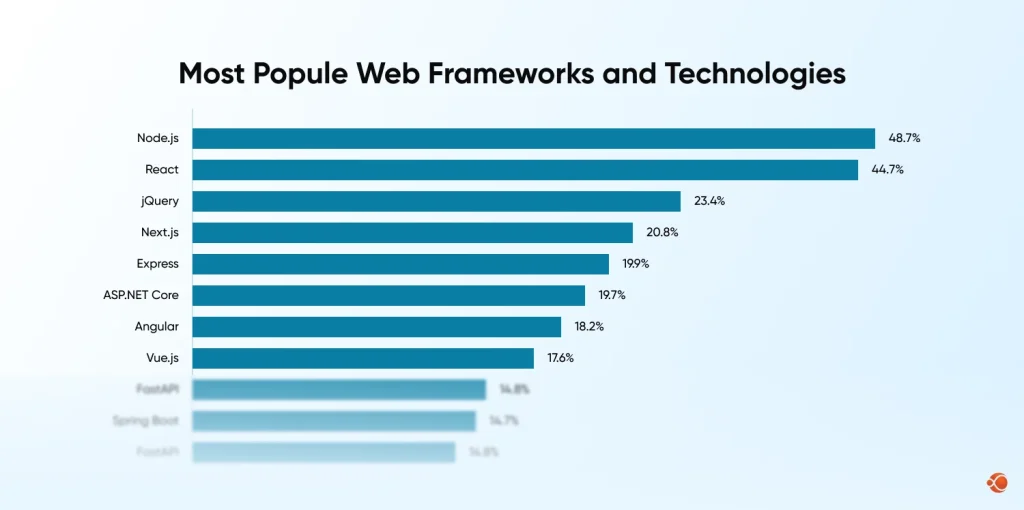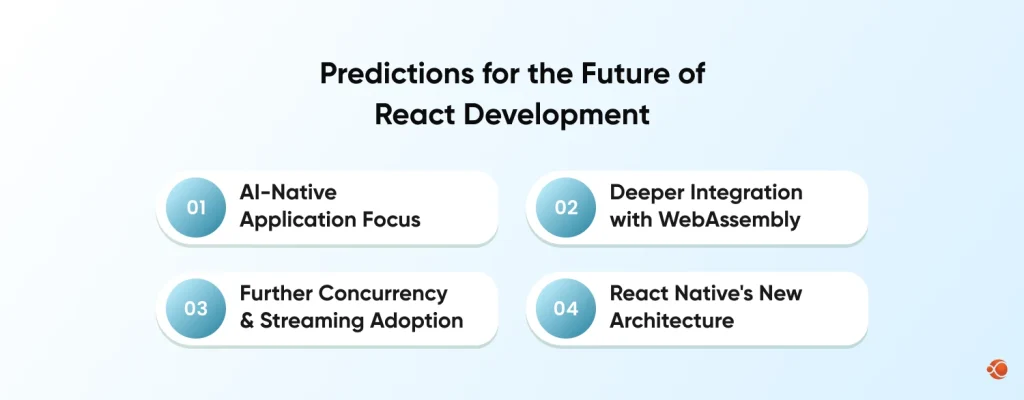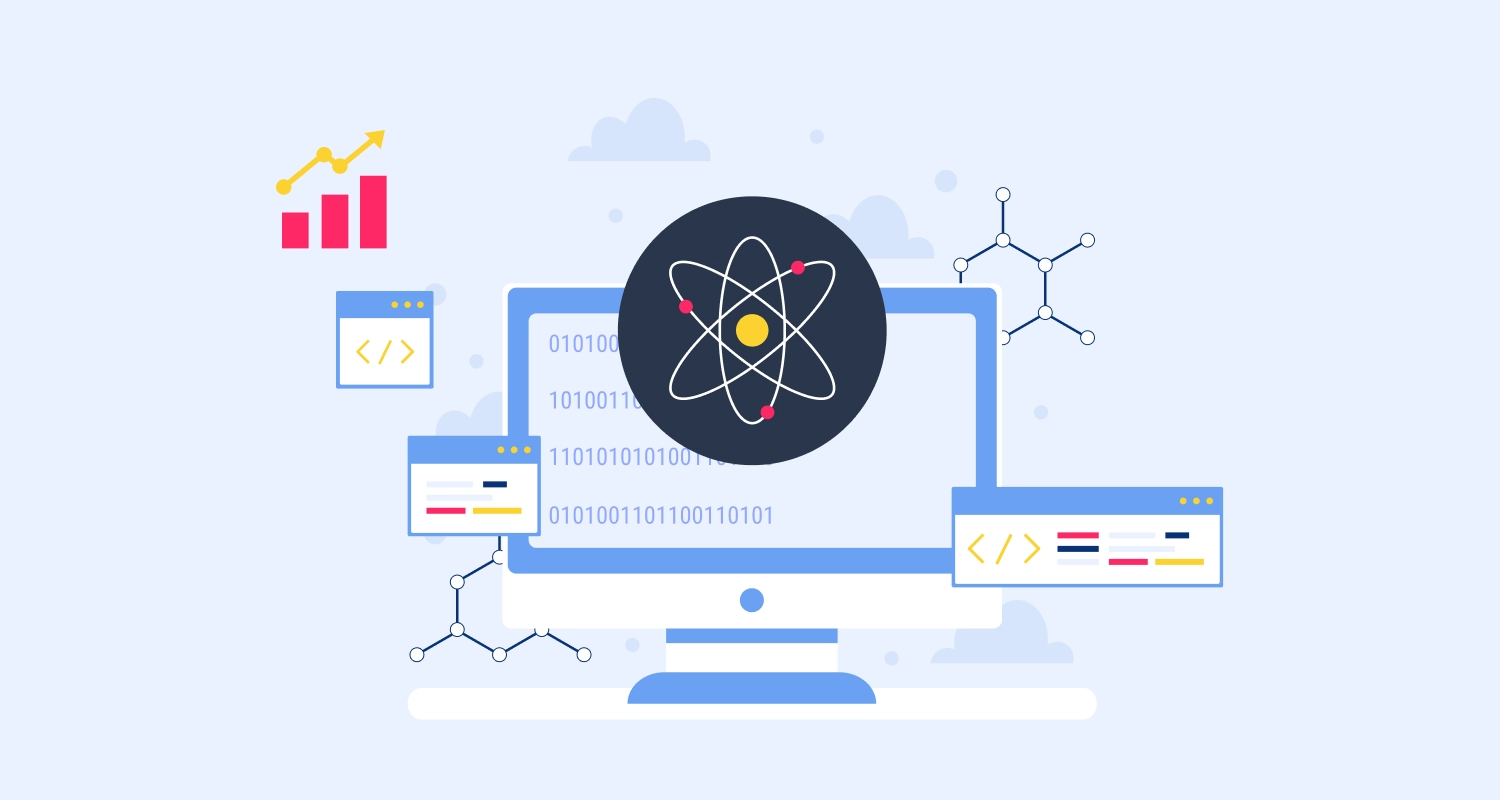Quick Summary: What are the top React.js development trends agencies are using in 2026 to build blazing-fast, scalable apps? From server components to AI-driven workflows and Wasm integration, these cutting-edge practices empower agencies to deliver secure, high-performance applications that outpace the competition. These React JS trends are shaping how modern applications are built and giving forward-thinking teams a clear competitive advantage.
In 2026, React.js isn’t just in survival mode; it is fundamentally changing how modern web applications are built, setting new standards for an efficient developer’s experience. Agencies and companies that are not able to adapt to these shifts risk being stuck with slow, outdated applications while competitors deliver near-instant, smooth user experiences.
The main reason for React’s resilience lies in its ecosystem’s ability to evolve and embrace radical changes, from Hooks replacing classes to the current shift toward the server. We’re moving into the era where the application’s speed is determined by milliseconds and where the frontend is no longer a separate concern from the backend. React is the driving engine of this unification. React continues to be the most used and popular web development technology by 44.7%, according to Stack Overflow’s annual developer survey.

This guide is your in-depth exploration of the React.js development trends that companies such as CMARIX put into practice to create powerful, future-ready digital experiences.
What is React.js?
At its heart, React.js is a JavaScript library for building user interfaces. It popularized component-based architecture: the idea of breaking down a complex interface of a website or app screen into smaller, reusable, self-contained pieces of code. Making React for web development and mobile development more efficient.
Imagine building a city out of pre-fabricated blocks rather than carving it out of stone. Similarly, in a website or application, each block represents a button, a navigation bar, or a product card, making development faster and debugging simpler. This foundational idea is why React scales so effectively from a simple landing page to an application used by millions.
Why Do Agencies Prefer React for Web Development?
For React to be a strategic business decision for web development is not just a technical one. The core strengths of the React ecosystem offer tangible business benefits that directly translate into lower costs, better performance, and higher quality for clients. This is the reason why most of businesses now turn to specialized Reactjs development services to achieve these advantages.
Ecosystem Maturity & Talent Pool
No other frontend technology provides the same level of global support. React’s huge community means:
- Extensive Tooling: If you need a utility for state management, animation, or testing, a proven, well-documented React solution already exists.
- Specialized Developers: Agencies have access to the largest pool of readily available specialized developers globally, making it easier to scale teams quickly for large projects. This is an important advantage for any React agency trends watch list.
Unmatched Scalability (Enterprise Readiness)
React’s component reusability is for managing complexity. Once a component is built, it can be dropped into any part of the application. This is not just a technical convenience, it’s an economic one. Agencies can use component libraries to drastically reduce the development time on subsequent projects, making it ideal for complex, enterprise-level applications where code maintenance is a major long-term cost.
Speed to Market (MVP & Prototyping)
The vast availability of high-quality, pre-built components and UI libraries (like Material UI or Chakra UI) allows React JS agencies to accelerate initial development cycles. A functional Minimum Viable Product can be delivered faster than with less mature frameworks, providing clients with quicker feedback loops and a lower initial investment.
SEO and Performance Optimization
Traditional single-page applications often struggled with search engine optimization (SEO) because content was rendered only after the JavaScript had loaded. React solved this by integrating closely with strategies like Static Site Generation(SSG) and Server-Side Rendering (SSR) through meta-frameworks. This capability is paramount to performance optimization React, ensuring sites meet Google’s crucial Core Web Vitals for responsiveness and speed.
Cross-Platform Consistency
With React Native, the same developer skill set and, often, significant portions of the core business logic can be leveraged to build native mobile applications for iOS and Android. This cross-platform consistency is highly valuable, allowing a React js agency to offer a unified digital product suite from a single, skilled React.js development agency.

Top React.js Development Trends Agencies Are Using in 2026
The real differentiator for a modern React JS development trends agencies list is not merely using React, but how they use it. The following trends represent a cutting-edge development, focused on performance, scale, and efficiency.
Here are the Top 7 React.js development trends to look for:
- Shift to Server Components (RSC)
- AI-Augmented Workflows
- Framework-Centric Development
- Modern State Management
- Micro-Frontend Architecture
- Behavior-Driven Testing (BDT) with RTL
- Integration of WebAssembly (WASM) for Critical Performance
1. Shift to Server Components (RSC)
The shift to server components is arguably the most transformative trend in the React world.
React Server Components (RSC) allow developers to render components entirely on the server before any JavaScript is sent to the browser. The result is pure CSS and HTML delivered initially. This drastic change means applications ship zero JavaScript for initial render, drastically improving the crucial First Contentful Paint (FCP) and overall load times. For performance-sensitive applications, RSC is no longer a future idea; it’s the current best practice. Also, in the list of the latest trends in react.js RSC is the most important one.
2. AI-Augmented Workflows
Artificial Intelligence is now a direct partner in the code editor. This is the definition of AI integration in React js. And it is also one of the most popular React JS agencies trends.
Integrating AI coding assistants like Copilot or specialized in-house tools into the development environment. These tools are used for:
- Test Writing: Drafting initial unit and integration tests, freeing up developer time for complex logic.
- Bug Identification: Proactively spotting security flaws and performance bottlenecks during the writing process.
- Boilerplate Generation: Instantly creating hooks and components based on simple text prompts.
This trend significantly enhances the efficiency of the AI software development service.
3. Framework-Centric Development
The days of setting up a plain React application with just a bare-bones tool like Create React App are largely over for modern agencies.
Agencies now default to powerful meta-frameworks like Next.js and Remix. These tools offer a complete architectural solution out of the box, covering everything a modern web app needs:
- Advanced routing
- Multiple rendering strategies (SSR, SSG, Incremental Static Regeneration)
- API routes and server functions (known as Server Actions)
This streamlines development, allowing the team to focus purely on business logic rather than configuration.
4. Modern State Management
The community has moved past the heavy configuration and boilerplate often associated with older state management patterns.
Agencies are opting for lighter, more intuitive global state solutions, such as Jotai and Zustand, for client-side state management, which require minimal setup and code. Crucially, they use TanStack Query to manage server state. This clear separation between UI state and server state greatly simplifies applications.
5. Micro-Frontend Architecture
As enterprise applications grow, they become complex and difficult to manage under a single, monolithic codebase.
Using React to build independent, composable parts of a single application, known as Micro-Frontends. This allows large agencies to assign different feature teams to separate codebases that can be built, tested, and deployed independently. This strategy minimizes dependencies between teams and allows for true scaling of development efforts.
6. Behavior-Driven Testing (BDT) with RTL
The philosophy of testing has shifted from checking internal functions to verifying the user’s journey.
Adopting React Testing Library (RTL) as the primary tool. RTL encourages developers to test components based on how a real user interacts with the rendered output (e.g., clicking a button and checking for a text change), rather than checking a component’s internal state or function calls. This React agency trends move toward BDT makes tests more robust and far less likely to break when the component’s internal logic is refactored.
7. Integration of WebAssembly (WASM) for Critical Performance
While JavaScript is fast, some computationally intensive tasks still need more raw power. This is where WebAssembly with React comes in.
For specialized, high-performance features such as real-time video processing, 3D rendering, or heavy data manipulation, complex financial charting, agencies are incorporating WebAssembly (WASM) modules. Wasm is a low-level binary instruction format that runs C, C++, or Rust Code at near-native speed in the browser. React is used to manage the standard UI and pass data, while WASM handles the critical computational heavy lifting, making sure the application remains responsive.
Predictions for the Future of React Development

AI-Native Application Focus
Rise of Large Language Models (LLMs) and Generative AI tools creates a new demand for sophisticated frontends. React.js agencies’ trends indicate a shift towards building complex conversational and data-visualization interfaces specifically for interacting with AI models. React, with its component-based model and flexibility, is perfectly positioned to become the primary tool for developing these intuitive, chat-based, and analytical AI frontends. For organisations looking to build such intuitive interfaces, it’s becoming increasingly important to hire React developers who already have experience in AI-integrated frontends.
Deeper Integration with WebAssembly (WASM)
WebAssembly (Wasm) is mainly known today for powering specialized, high-speed features, even though most developers rarely use it directly. Looking ahead, Wasm is on track to become a behind-the-scenes powerhouse, quietly boosting everyday libraries and tools. Picture this: opening a React app and interacting with a data grid that effortlessly filters and sorts massive datasets in a blink. React will serve as the coordination layer, making Wasm’s performance universally accessible for data-heavy applications.
Further Concurrency & Streaming Adoption
React’s foundational features for improved user experience(UI), like Suspense and Concurrent Mode, will become the stable, expected default. This means developers will build non-blocking UIs where data fetching, rendering delays, and state updates are handled gracefully without freezing the user interface. Users will see content streamed onto the page as it becomes available, creating a smooth, uninterrupted browsing experience.
React Native’s New Architecture
React has been a top choice of many agencies aiming to deliver compelling digital experiences, as it is extending beyond web development. For agencies providing cross-platform mobile services, the adoption of React Native’s new architecture is a game-changer. This new foundation offers improved performance, better type safety, and deeper integration with native platform specifics, significantly driving enterprise mobile adoption and consolidating React’s position as the leading choice for web and mobile.
Why Choose CMARIX for Your React.js Development Needs
CMARIX has been building React applications since the library’s early days, and we’ve evolved our approach alongside every major shift in the ecosystem. We’re not just observers of these trends; we’re actively using them in production for clients across industries.
Here’s what sets us apart:
AI-Augmented, But Human-Led
Yes, we use AI coding assistants to accelerate development. But our senior developers review every line, architect every system, and make the strategic decisions that determine whether your application succeeds or struggles under real-world pressure.
Mastery of React Design Patterns
We build maintainable, scalable code from day one using React design patterns such as compound components, render props, and custom hooks. This creates flexible architectures that grow with your business without accumulating technical debt, saving you time and money on future updates.
Cross-Platform Capability
Our React Native team follows the same architectural principles as our React.js team, enabling true code reuse for business logic and faster delivery of consistent experiences across web and mobile platforms.
Post-Launch Support
We provide ongoing monitoring, proactive updates, and performance optimization to keep your application running smoothly as the React ecosystem continues to evolve.
Final Words
React in 2026 isn’t the same library it was five years ago. It has evolved into a full-stack development paradigm that blurs the line between frontend and backend, prioritizing user experience and speed above all else. The trends we’ve covered aren’t experimental. They’re the current standard for agencies building competitive web applications. If your company isn’t using these approaches, you’re already behind.
When evaluating the cost to hire Reactjs developers, remember that expertise matters more than hourly rates. A developer who understands server components, performance optimization, and React design patterns will build applications that cost significantly less to maintain and scale. They’ll ship features faster, write cleaner code, and avoid the technical debt that drags down older projects.
FAQs for React.js Development Trends
How Do Agencies Adopt New React Trends in Real Projects?
Agencies adopt new trends by starting with stable frameworks like Next.js or Remix for immediate benefits (RSCs, Streaming), testing new features internally, and applying changes incrementally to existing client applications to avoid risk.
What Are React Server Components and Why Are They Important?
React Server Components (RSCs) run only on the server, sending no JavaScript to the client. They are vital because they drastically reduce client-side bundle size, improve initial load time (LCP), and allow for secure, direct data fetching on the server.
How Are Agencies Leveraging AI and ML Integration to Enhance User Experience?
Agencies use AI/ML to create hyper-personalized UIs (e.g., real-time recommendations, dynamic layouts) and build AI-Native interfaces like fluid chatbots and complex, yet user-friendly, data visualizations for model interaction.
What Challenges Might Developers Face in Adopting These Trends?
Developers face the challenge of shifting their mindset from Client-Side Rendering (CSR) to the Server-First paradigm, keeping up with the rapid pace of ecosystem updates, and dealing with the increased complexity of debugging logic that spans both the server and the client.
What Are the Key Strategies Agencies Use to Optimize React Apps for Core Web Vitals?
Key strategies include using SSR/SSG (Next.js, Remix) to boost LCP, aggressive code splitting and lazy loading to reduce bundle size, and reserving space for media to prevent layout shifts (CLS).







